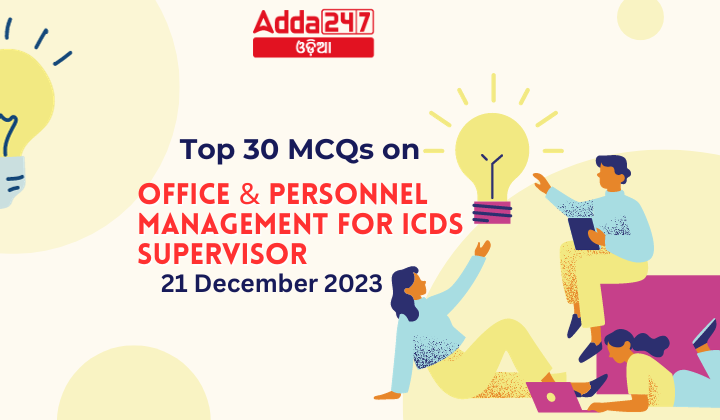Office and personnel management are crucial aspects of any organization, including Integrated Child Development Services (ICDS). For ICDS Supervisors, understanding the principles and practices of effective office and personnel management is essential for the smooth functioning of the program. This article presents a set of 30 Multiple Choice Questions (MCQs) along with their answers to test and enhance your knowledge in this domain.
Top 30 MCQs on Office & Personnel Management for ICDS Supervisor
1. Question: What is the primary purpose of office management?
- a. Maximizing profits
- b. Enhancing employee satisfaction
- c. Efficient use of resources
- d. Achieving social responsibility
Answer: c. Efficient use of resources
2. Question: Which of the following is a personnel management function?
- a. Budgeting
- b. Recruitment
- c. Marketing
- d. Product development
Answer: b. Recruitment
3. Question: The process of selecting, training, and developing employees is known as:
- a. Human resource planning
- b. Performance appraisal
- c. Employee orientation
- d. Staffing
Answer: d. Staffing
4. Question: What does SWOT stand for in the context of personnel management?
- a. Strengths, Weaknesses, Opportunities, Threats
- b. Staff, Work, Objectives, Targets
- c. Strategy, Workforce, Objectives, Tactics
- d. Success, Wisdom, Organization, Talent
Answer: a. Strengths, Weaknesses, Opportunities, Threats
5. Question: The process of dividing the work into tasks and assigning them to individuals is called:
- a. Delegation
- b. Decentralization
- c. Departmentalization
- d. Distribution
Answer: a. Delegation
6. Question: What is the purpose of an organizational chart?
- a. Employee motivation
- b. Communication structure
- c. Performance evaluation
- d. Budgeting
Answer: b. Communication structure
7. Question: In the context of personnel management, what does the term “Onboarding” refer to?
- a. Employee termination
- b. Employee training and orientation
- c. Employee promotion
- d. Employee appraisal
Answer: b. Employee training and orientation
8. Question: Which leadership style focuses on employee participation in decision-making?
- a. Autocratic
- b. Democratic
- c. Laissez-faire
- d. Transactional
Answer: b. Democratic
9. Question: The process of comparing actual performance with planned performance is known as:
- a. Benchmarking
- b. Performance appraisal
- c. Monitoring
- d. Controlling
Answer: d. Controlling
10. Question: What is the purpose of a grievance-handling procedure?
- a. Employee motivation
- b. Conflict resolution
- c. Performance evaluation
- d. Job analysis
Answer: b. Conflict resolution
11. Question: The concept of “Span of Control” refers to:
- a. Number of employees reporting to a supervisor
- b. Number of supervisors in an organization
- c. Employee turnover rate
- d. Employee training duration
Answer: a. Number of employees reporting to a supervisor
12. Question: What is the primary objective of performance appraisal?
- a. Employee discipline
- b. Employee motivation
- c. Employee development
- d. Employee termination
Answer: c. Employee development
13. Question: What is the purpose of a job description?
- a. Employee motivation
- b. Employee discipline
- c. Employee training
- d. Employee recruitment
Answer: d. Employee recruitment
14. Question: Which of the following is an intrinsic motivator?
- a. Salary
- b. Job security
- c. Recognition
- d. Working conditions
Answer: c. Recognition
15. Question: The process of acquiring, training, and retaining employees is known as:
- a. Recruitment
- b. Human resource planning
- c. Employee retention
- d. Compensation management
Answer: c. Employee retention
16. Question: What is the purpose of a code of conduct in the workplace?
- a. Employee discipline
- b. Employee motivation
- c. Employee training
- d. Employee recruitment
Answer: a. Employee discipline
17. Question: Which of the following is an external factor affecting personnel management?
- a. Company policies
- b. Government regulations
- c. Organizational culture
- d. Employee attitudes
Answer: b. Government regulations
18. Question: The process of identifying and analyzing tasks, duties, and responsibilities related to a job is called:
- a. Job evaluation
- b. Job enrichment
- c. Job analysis
- d. Job rotation
Answer: c. Job analysis
19. Question: Which of the following is a benefit of effective communication in the workplace?
- a. Increased conflict
- b. Reduced productivity
- c. Improved teamwork
- d. Lower employee morale
Answer: c. Improved teamwork
20. Question: What is the purpose of a performance improvement plan?
- a. Employee discipline
- b. Employee motivation
- c. Employee training
- d. Employee termination
Answer: a. Employee discipline
21. Question: The process of determining the future human resource needs of an organization is known as:
- a. Recruitment
- b. Human resource planning
- c. Staffing
- d. Training
Answer: b. Human resource planning
22. Question: Which type of conflict resolution involves finding a solution that satisfies both parties involved?
- a. Collaborative
- b. Compromising
- c. Avoiding
- d. Competing
Answer: a. Collaborative
23. Question: What is the purpose of a probationary period for new employees?
- a. Employee discipline
- b. Employee motivation
- c. Employee training
- d. Employee assessment
Answer: d. Employee assessment
24. Question: Which of the following is a characteristic of a high-performance team?
- a. Lack of communication
- b. Low levels of trust
- c. Clear goals and objectives
- d. Individualistic mindset
Answer: c. Clear goals and objectives
25. Question: What is the significance of diversity management in the workplace?
- a. Decreased innovation
- b. Improved employee satisfaction
- c. Higher employee turnover
- d. Limited creativity
Answer: b. Improved employee satisfaction
26. Question: The process of systematically evaluating a job’s worth within an organization is known as:
- a. Job evaluation
- b. Job rotation
- c. Job analysis
- d. Job enrichment
Answer: a. Job evaluation
27. Question: What is the purpose of an exit interview?
- a. Employee motivation
- b. Employee termination
- c. Employee training
- d. Employee assessment
Answer: b. Employee termination
28. Question: Which leadership style involves a leader who is hands-off and allows subordinates to make decisions?
- a. Autocratic
- b. Democratic
- c. Laissez-faire
- d. Transactional
Answer: c. Laissez-faire
29. Question: What is the purpose of a performance appraisal?
- a. Employee discipline
- b. Employee motivation
- c. Employee development
- d. Employee termination
Answer: c. Employee development
30. Question: The process of guiding and influencing employees to achieve organizational goals is known as:
- a. Leadership
- b. Management
- c. Administration
- d. Supervision
Answer: a. Leadership










